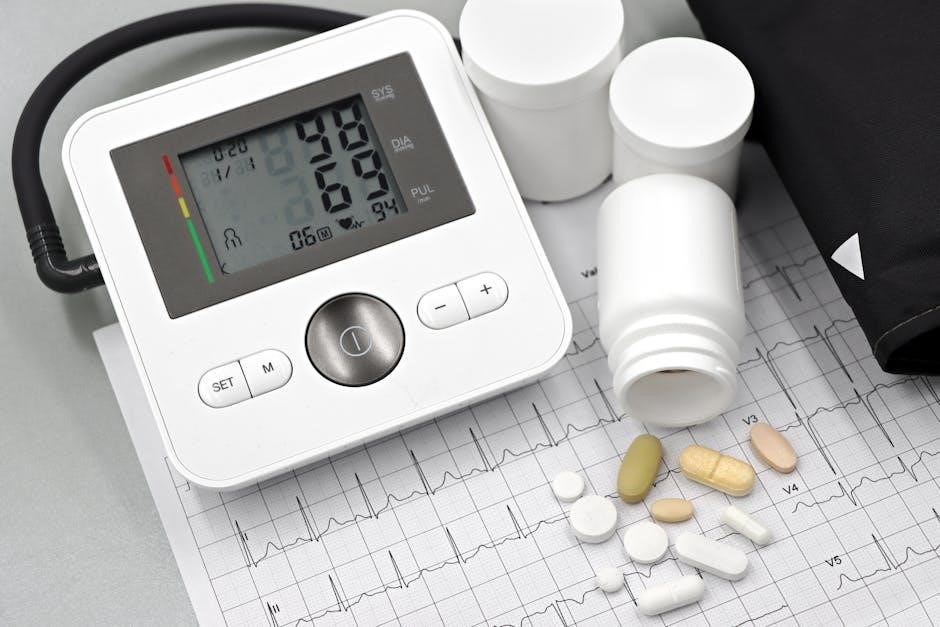Myasthenia gravis (MG) is a chronic autoimmune disorder affecting nerve-muscle communication. Drug sensitivity plays a critical role in managing symptoms, as certain medications can exacerbate weakness and trigger crises. Awareness of specific drugs to avoid is essential for optimizing treatment plans and preventing complications.
Overview of Myasthenia Gravis (MG)
Myasthenia gravis (MG) is a chronic autoimmune disorder characterized by muscle weakness and fatigue, particularly in voluntary muscles. It occurs when the immune system mistakenly attacks acetylcholine receptors at the neuromuscular junction, disrupting nerve-muscle communication. Symptoms often worsen with activity and improve with rest. Common manifestations include drooping eyelids, double vision, difficulty speaking, and muscle weakness in the arms and legs. The severity of MG varies widely among patients, with some experiencing mild symptoms and others facing severe, life-threatening complications. While the exact cause remains unclear, treatment focuses on managing symptoms, improving quality of life, and suppressing the immune system’s abnormal response; Early diagnosis and tailored therapies are crucial for optimal outcomes.
Importance of Drug Avoidance in Managing MG
Drug avoidance is a cornerstone in managing myasthenia gravis (MG), as certain medications can exacerbate symptoms, trigger severe relapses, or even lead to myasthenic crises. Patients with MG are particularly sensitive to drugs that impair neuromuscular transmission or suppress the immune system. Avoiding these medications prevents complications and maintains disease stability. For instance, antibiotics like fluoroquinolones and aminoglycosides, commonly used to treat infections, can worsen MG symptoms. Similarly, anesthetics and muscle relaxants require careful consideration to prevent respiratory failure during surgery. Understanding which drugs to avoid ensures safer treatment options and improves overall patient outcomes. This proactive approach minimizes risks and enhances the effectiveness of MG management strategies.

Categories of Drugs to Avoid in Myasthenia Gravis
Certain drug categories, such as antibiotics, anesthetics, cardiovascular medications, and neurological agents, can worsen MG symptoms. These drugs may impair neuromuscular transmission or exacerbate muscle weakness, necessitating cautious use or avoidance to ensure patient safety and disease management. Detailed lists of specific drugs within these categories are essential for guiding clinical decision-making and preventing adverse reactions.
Antibiotics
Antibiotics are a key category of drugs that can exacerbate myasthenia gravis symptoms. Fluoroquinolones, such as ciprofloxacin and levofloxacin, are known to worsen muscle weakness and should be avoided. Macrolides like azithromycin and erythromycin, while generally safer, may still pose risks in some patients. Aminoglycosides, including gentamicin and amikacin, are particularly hazardous due to their direct effects on neuromuscular transmission; Telithromycin, a ketolide antibiotic, has been linked to severe reactions in MG patients. It is crucial for healthcare providers to carefully weigh the benefits and risks of using these antibiotics in individuals with MG, as even seemingly mild interactions can lead to significant clinical deterioration. Patient-specific factors, such as disease severity, should guide antibiotic selection to minimize adverse outcomes.
Anesthesia and Muscle Relaxants
Anesthesia and muscle relaxants pose significant risks for individuals with myasthenia gravis. Depolarizing agents like succinylcholine can cause prolonged paralysis, while non-depolarizing agents, such as rocuronium and vecuronium, may exacerbate muscle weakness. These drugs interfere with neuromuscular transmission, worsening MG symptoms; Even volatile anesthetics like isoflurane and sevoflurane should be used cautiously, as they can potentiate muscle relaxation. Patients with MG require tailored anesthetic plans to avoid complications; Close monitoring and alternative agents, such as propofol, are often recommended. Consulting an anesthesiologist experienced in MG is crucial to ensure safe perioperative care and minimize risks associated with these medications.

Cardiovascular Drugs
Cardiovascular drugs, particularly beta-blockers and calcium channel blockers, can worsen myasthenia gravis symptoms. Beta-blockers like propranolol and metoprolol reduce acetylcholine release, exacerbating muscle weakness. Calcium channel blockers, such as diltiazem and verapamil, also impair neuromuscular transmission. Additionally, antiarrhythmic drugs like amiodarone and certain antihypertensives may trigger or worsen MG. Patients with MG require careful monitoring when using these medications, as they can lead to respiratory failure or myasthenic crisis. Some drugs in this category may need to be avoided entirely, while others can be used cautiously under close medical supervision. A personalized management plan is essential to balance cardiovascular health and MG symptom control effectively.
Neurological and Psychiatric Medications
Neurological and psychiatric medications can significantly impact myasthenia gravis (MG) symptoms. Drugs like phenytoin and carbamazepine, used for epilepsy, reduce acetylcholine release, worsening muscle weakness. Psychiatric drugs such as chlorpromazine and haloperidol also exacerbate symptoms due to their neuromuscular-blocking effects. Additionally, certain anesthetics and muscle relaxants, like succinylcholine and vecuronium, can cause prolonged paralysis or respiratory failure in MG patients. It is crucial to carefully evaluate the risks and benefits of these medications and consider alternative treatments when possible. Close medical supervision is essential to prevent complications and ensure safe management of both neurological and psychiatric conditions alongside MG.
Anti-Inflammatory and Immunosuppressive Drugs
While some anti-inflammatory and immunosuppressive drugs are used to manage myasthenia gravis (MG), others can worsen symptoms. Corticosteroids, such as prednisone, are commonly prescribed to suppress the immune system and reduce MG severity. However, certain biologics like interleukin-1 receptor inhibitors and tumor necrosis factor-alpha (TNF-alpha) blockers may exacerbate neuromuscular weakness. Additionally, drugs like rituximab and eculizumab, which target specific immune pathways, require careful consideration due to their potential to interfere with MG treatment. Nonsteroidal anti-inflammatory drugs (NSAIDs) are generally safe but should be used cautiously. Always consult FDA guidelines and healthcare providers before starting or adjusting these medications to ensure safe and effective management of MG.

Specific Drugs to Avoid
Certain drugs like fluoroquinolones, macrolides, and aminoglycosides can worsen MG symptoms. Beta-blockers and calcium channel blockers may exacerbate muscle weakness. Botox and botulinum toxin should also be avoided due to potential neuromuscular risks.
Fluoroquinolones
Fluoroquinolones, such as ciprofloxacin and levofloxacin, are antibiotics known to exacerbate myasthenia gravis symptoms. These drugs can trigger muscle weakness, respiratory issues, and even MG crises. The FDA has issued warnings about their use in MG patients. Studies show fluoroquinolones interfere with neuromuscular transmission, worsening symptoms. Patients should avoid these antibiotics unless no alternatives are available. Telithromycin, a ketolide antibiotic, has caused severe reactions in MG patients, including fatalities. Always consult a healthcare provider before starting any fluoroquinolone or related medication. Awareness of these risks is crucial for managing MG effectively and preventing complications.
Macrolides

Macrolides, such as erythromycin, azithromycin, and clarithromycin, are antibiotics that can worsen myasthenia gravis symptoms in some patients. While they are generally safer than fluoroquinolones, they may still trigger muscle weakness, respiratory issues, or exacerbate fatigue. Studies indicate that macrolides can interfere with neuromuscular transmission, potentially leading to symptom flares. Patients with MG should exercise caution when using these drugs and discuss alternative treatments with their healthcare provider. It is crucial to weigh the benefits and risks before starting macrolide therapy, especially in severe MG cases. Always prioritize consulting a doctor to ensure safe and effective treatment.
Aminoglycosides
Aminoglycosides, such as gentamicin and tobramycin, are potent antibiotics that can significantly worsen myasthenia gravis symptoms. These drugs interfere with neuromuscular transmission, leading to increased muscle weakness, respiratory difficulties, and potentially life-threatening crises. Their mechanism of action involves blocking acetylcholine receptors, exacerbating the underlying defect in MG. Patients with MG should avoid aminoglycosides whenever possible, as even short-term use can trigger severe flares. Alternative antibiotics with a safer profile should be considered. If aminoglycosides are deemed necessary, close monitoring in a clinical setting is essential to manage potential complications promptly. Always consult a healthcare provider before initiating therapy with these drugs.
Beta-Blockers and Calcium Channel Blockers
Beta-blockers and calcium channel blockers are commonly used to manage cardiovascular conditions but can worsen myasthenia gravis symptoms. Beta-blockers, such as propranolol, can impair neuromuscular transmission, leading to increased muscle weakness and fatigue. Similarly, calcium channel blockers, like verapamil, reduce acetylcholine release at the neuromuscular junction, exacerbating MG symptoms. These effects can be particularly problematic for patients with pre-existing respiratory or bulbar involvement. While these drugs are not absolutely contraindicated, their use requires careful consideration and monitoring. Patients should discuss alternative treatments with their healthcare provider to minimize risks. Avoiding these medications is often recommended to prevent symptom flare-ups and ensure better disease management.
Botox and Botulinum Toxin
Botox and botulinum toxin are potent neurotoxins that inhibit acetylcholine release at the neuromuscular junction, worsening myasthenia gravis symptoms. While Botox is commonly used for cosmetic purposes and certain neurological conditions, its use in MG patients is contraindicated due to the risk of severe muscle weakness, respiratory failure, and other complications. Botulinum toxin, even in small amounts, can exacerbate MG symptoms, making it essential to avoid these agents entirely. Patients with MG should inform their healthcare providers about their condition before considering any treatments involving botulinum toxin. Alternative therapies should be explored to manage conditions like dystonia or spasticity without compromising MG stability.

Special Considerations
Drug interactions, patient-specific factors, and FDA guidelines play a crucial role in managing myasthenia gravis. Tailored approaches ensure safe treatment, minimizing risks and optimizing outcomes for patients.
Drug Interactions and Warnings
Drug interactions pose significant risks for individuals with myasthenia gravis, as certain medications can exacerbate symptoms or trigger crises. Fluoroquinolones, such as ciprofloxacin, are well-documented to worsen MG, while macrolides like azithromycin may also pose risks. Additionally, aminoglycosides, like gentamicin, can impair neuromuscular transmission, worsening weakness. Patients must be vigilant about combining MG medications with other drugs, as unintended interactions can lead to severe adverse effects. The FDA has issued warnings about specific drug combinations, emphasizing the need for careful monitoring. Consulting healthcare providers before starting or stopping any medication is crucial to avoid dangerous interactions and ensure safe treatment outcomes for MG patients.
Patient-Specific Factors in Drug Avoidance
Patient-specific factors play a crucial role in determining which drugs to avoid in myasthenia gravis (MG); Disease severity, age, and comorbidities influence medication tolerance and risk of exacerbation. For instance, older adults may be more sensitive to certain antibiotics or muscle relaxants, while patients with cardiovascular conditions must avoid beta-blockers or calcium channel blockers. Additionally, individual responses to drugs vary, as some patients may experience severe reactions to medications that are generally well-tolerated. Personalized treatment plans are essential, considering each patient’s unique health profile. Regular monitoring and open communication with healthcare providers ensure tailored drug avoidance strategies, optimizing safety and symptom management. This individualized approach minimizes risks and improves overall quality of life for MG patients.
Role of FDA Guidelines and Consensus Reports
FDA guidelines and consensus reports provide critical frameworks for managing drug sensitivity in myasthenia gravis (MG). The FDA has issued warnings about specific medications, such as fluoroquinolones, due to their potential to exacerbate MG symptoms. Consensus reports from medical organizations highlight evidence-based recommendations for avoiding harmful drugs. For example, the FDA’s adverse event reporting system has flagged certain antibiotics and neuromuscular blockers as high-risk. These guidelines help clinicians make informed decisions, ensuring safer treatment plans. Regular updates to these reports reflect evolving research and clinical experiences, offering a reliable resource for both patients and healthcare providers. Adherence to these guidelines minimizes risks and improves outcomes for MG patients.
Avoiding specific drugs is crucial for managing myasthenia gravis. Careful medication selection and healthcare provider consultation ensure safety and effectiveness, adhering to guidelines for optimal outcomes.
In managing myasthenia gravis, certain drugs must be avoided to prevent symptom exacerbation. Key drugs to avoid include fluoroquinolones, macrolides, and aminoglycosides, as they can worsen muscle weakness. Beta-blockers and calcium channel blockers should also be used with caution due to their potential to impair neuromuscular transmission. Additionally, Botox and botulinum toxin are contraindicated, as they can trigger severe weakness. Patients should consult their healthcare providers before starting any new medications to ensure safe and effective treatment. Adhering to these guidelines helps optimize outcomes and minimize risks for individuals with MG.
Final Recommendations for Safe Drug Use in MG
Safe drug use in myasthenia gravis requires careful scrutiny of all medications. Patients should maintain open communication with healthcare providers to review potential drug interactions. Regular monitoring of symptoms and medication responses is crucial. A personalized approach, considering the severity of MG and comorbidities, ensures tailored treatment plans. Avoiding high-risk drugs like fluoroquinolones and aminoglycosides is essential. Alternative therapies should be explored when necessary. Adherence to FDA guidelines and consensus reports can further enhance safety. By prioritizing cautious prescribing and patient education, the risk of adverse reactions is minimized, improving overall quality of life for those with MG.


